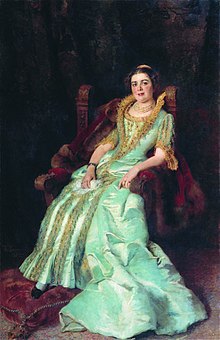Varvara Alexejewna Morozova
Varvara Alexejewna Morozova , born Varvara Alexejewna Chludowa , ( Russian Варвара Алексеевна Морозова , maiden name Russian Варвара Алексеевна Хлудова ; born 2 November . Jul / 14. November 1848 greg. In Moscow , † September 4 jul. / 17th September 1917 greg. ibid) was a Russian entrepreneur and patron .
Life
Varvara Alexejewna was the daughter of the old-believing entrepreneur and book collector Alexei Ivanovich Chludow . She lost her mother at the age of 6. In 1869 she married her second uncle Abram Abramowitsch Morosow (second cousin of Sawwa Timofejewitsch Morosow ). Abram Morozov was a co-owner of the Tverskaya Manufaktura textile company , which he ran with his brother David. In 1858 a hospital was established at the factory and in 1861 a maternity hospital. In 1869 a trade school for underage factory workers followed. In her marriage to Abram Morosow, Varwara Morosowa had three sons, Michail , Ivan and Arsseni .
1871 Morozova With general partner of the company Tverskaya Manufaktura. In 1873 they set up an elementary school in their shared house. In 1877 she expanded the school into a trade school, which was the first trade school in Moscow. When her husband died of progressive paralysis in 1882 , she took over the management of Tverskaya Manufaktura until her sons came of age.
Soon after her husband's death, Morosowa lived in a civil marriage with Vasily Michailowitsch Sobolewski , the editor and editor of the Morosova-supported Russkije vedomosti and a member of the Cadets . With regard to inheritance problems, the recognition of this marriage was omitted, so that the children Gleb and Natalja from this second marriage also received the family name Morosow. In her house, built by Roman Ivanovich Klein in 1886 , Morosova opened a literary salon , which Alexander Alexandrowitsch Blok , Valeri Jakowlewitsch Brjussow , Andrei Bely and Vladimir Sergeyevich Solovyov visited. Her sons Ivan and Mikhail collected paintings by the Impressionists , which are now the pride of the Pushkin Museum . Morosova was the model for the heroine Anna Serafimovna Stanitsyna in Pyotr Dmitrijewitsch Boborykin's novel Kitai-Gorod (1882).
In memory of her deceased husband, Morosova had a psychiatric clinic built on the Dewitschje Pole , which she handed over to the Imperial University of Moscow with the acquired property . This was the beginning of the later Klinichesky Gorodok on the Devichye Pole. In 1885 Morozova opened the first public, free reading room for 100 readers named after Ivan Sergeyevich Turgenev with a large collection of books, which became the Turgenev library . In 1888 she financed the construction of a research laboratory for the university's botanical garden . In 1891 she donated the capital for the university's WW Dolgorukov scholarship . In 1892 she received imperial thanks for her support from the university. As the curator of the Morosow trade school, she was honored in 1898 with the gold medal for duty to be worn on the Alexander ribbon. In 1899 their trade school was given its own building and was handed over to the city of Moscow in 1901. She financed other schools. As the first of the Morozovs, she donated 30,000 rubles to the Cancer Institute, founded in 1903 . She was an honorary member of the Society for the Assistance of Inefficient Students at the University. For the establishment of the Municipal Moscow Schanjawski - People's University she donated 50,000 rubles. Thanks to her support, a dormitory was built for students of the Imperial Technical School , and she was chairman and honorary member of the Society for the Support of Needy Students of this university.
According to the memories of her daughter Natalja, a group of Bolsheviks , including Ivan Ivanovich Skworzow-Stepanov and Sergei Ivanovich Mitskewitsch , met in Morozova's house during the 1905 revolution . For many arrested Bolsheviks, she provided the bail and enabled many to flee abroad. She financed the free Pretschistenka worker courses, participated in the management and had a building built for it.
Morosowa was buried in the Wagankowo Cemetery . In 2005, on the initiative of the Turgenev Library, a tombstone based on a design by her great-great-granddaughter JG Demjanowa was placed on her grave.
Individual evidence
- ↑ a b c d Елена Широкова: 164 года со дня рождения В.А. Морозовой (accessed January 5, 2019).
- ↑ a b c d Варвара Алексеевна Морозова: деловая женщина с добрым сердцем (accessed January 5, 2019).
- ↑ a b c d В. А. Морозова (accessed January 5, 2019).
- ↑ a b c Варвара Алексеевна Морозова: На благо просвещения Москвы (2008 год) (accessed January 5, 2019).
- ↑ a b Е. Ю. Горбунова: Благотворители и меценаты в истории Московского университета . Издательство Московского университета, Moscow 2010, ISBN 978-5-211-05745-6 , p. 303 .
| personal data | |
|---|---|
| SURNAME | Morosowa, Varvara Alexejewna |
| ALTERNATIVE NAMES | Chludowa, Varvara Alexejewna (maiden name); Морозова, Варвара Алексеевна (Russian) |
| BRIEF DESCRIPTION | Russian textile entrepreneur and patron |
| DATE OF BIRTH | November 14, 1848 |
| PLACE OF BIRTH | Moscow |
| DATE OF DEATH | September 17, 1917 |
| Place of death | Moscow |
